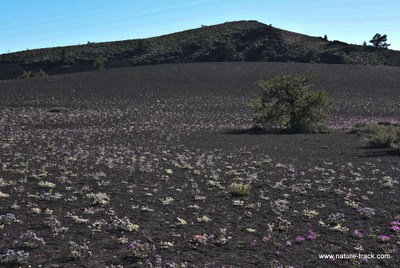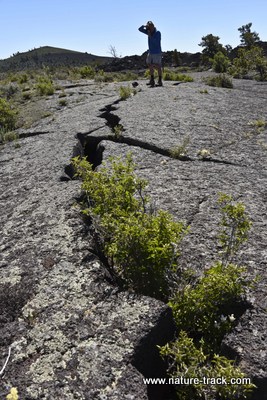Plants at Craters of the Moon

Dwarf buckwheat can grow in the cinders by establishing a large root system. Root systems don’t overlap with neighboring plants creating the impression that the impression they have been planted by hand.

Syringa, Idaho’s state flower and a shrub one would normally associate with cool forests, can thrive in the unique habitat found deep within lava cracks.
In some places, lava cinders crunch underfoot. In others, jagged aa lava or the ropy, pahoehoe lava cover the land like a blanket and shred boot soles. The brilliant white sun overhead floods the ground with scorching rays which the black lava absorbs and radiates back, cranking the surface temperature up as high as 150 degrees Fahrenheit.
There are places in this harsh landscape where, if it weren’t for the searing air entering my lungs, I could believe myself on the real surface of the moon. Yet, unlike the moon, plant life thrives here.
Craters of the Moon National Monument boasts over 750 plant species and as many as 35 distinct plant communities. Part of that owes to the fact that not all of Craters of the Moon is lava. Especially on the north end, there are stream communities, aspen groves and Douglas fir stands. Yet even the most treacherous of lava flows can support an amazing array of plant life adapted to living under exceptionally tough conditions.
Plants that thrive in the lavas and cinders must overcome a triple whammy of low moisture, poor soils and high heat. Many of the plants have developed simple strategies to combat these obstacles. For instance, many plants have silvery leaves that reflect sunlight. Some also are covered in tiny hairs that helps to reflect sunlight and retain water.
But there are other strategies as well. Looking across a field of gravel-sized cinders, it looks like the flowering plants have been spaced by a meticulous gardener. However, the tiny plants have an broad root system that can soak up the rare summer shower. They space themselves naturally to match the limited resource of water and to avoid competition from the neighbors.
Many of the plants at Craters are also short-statured. While this keeps them down in that 150 degree Fahrenheit zone, it also minimizes the impact of the almost ever present wind that can suck moisture from a plant like soda through a straw.
Other plants live in crevices, cracks in the lava that may be six inches to several feet across and from several inches to many feet deep. The bottoms of these crevices are often cool and moist and protected from the wind. The habitat is so different from the surface that moisture and shade loving plants such as ferns, thrive there. Craters of the Moon boasts at least three different species of ferns.
While lava does eventually breakdown into a coarse soil, most of the soil provided to the plants comes on the breeze. Wind deposited soil, called loess, settles in cracks and piles up in deposition areas. As plants establish in the soil, they capture more soil and pave the way for a later successional stage to follow.
The plants at Craters of the Moon are evidence of that famous line from the movie, Jurassic Park--“Life will find a way”. All we have to do is give nature a little room and a chance and it can do the rest.

Wildlife License Plates
Great news! as of 2024, there are three NEW designs for license plates. They still are bluebird, cutthroat trout and elk, but they are beautiful.
Idaho Wildlife license plates provide essential funding that benefits the great diversity of native plants and wildlife that are not hunted, fished or trapped—over 10,000 species or 98% of Idaho’s species diversity. Game species that share the same habitats (such as elk, deer, antelope, sage-grouse, salmon, trout) also benefit from these specialty plates.
No state tax dollars are provided for wildlife diversity, conservation education and recreation programs. Neither are any revenues from the sale of hunting or fishing licenses spent on nongame species. Instead, these species depend on direct donations, federal grants, fundraising initiatives—and the Idaho Wildlife license plates.
Both my vehicles have Bluebird Plates. I prefer the bluebird because the nongame program gets 70 percent of the money from bluebird plates, but only 60 percent of the money from elk and trout plates - 10 percent of the money from elk plates supports wildlife disease monitoring and testing programs (to benefit the livestock industry) and 10 percent from cutthroat plates supports non-motorized boat access.
Incidentally, in 2014, the Idaho Legislature denied the Department of Fish and Game the ability to add new plates or even to change the name of the elk and cutthroat plates (very specific) to wildlife and fish plates, a move that would have allowed for changing images occasionally and generating more revenue. It would seem that they believe that we Idahoans don't want a well funded wildlife program.
I think it is time we let the Legislature know that Idahoan support wildlife funding and that we would like to see these generic plates come to fruition.

"WOW. What a phenomenal piece you wrote. You are amazing." Jennifer Jackson
That is embarrassing, but actually a fairly typical response to my nature essays. Since The Best of Nature is created from the very best of 16 years of these nature essays published weekly in the Idaho Falls Post Register (online readership 70,000), it is a fine read. It covers a wide variety of topics including humorous glimpses of nature, philosophy, natural history, and conservation. Readers praise the style, breadth of subject matter and my ability to communicate complex and emotional topics in a relaxed and understandable manner.
Everyone can find something to love in this book. From teenagers to octogenarians, from the coffee shop to the school room, these nature essays are widely read and enjoyed.
Some of the essays here are my personal favorites, others seemed to strike a chord with readers. Most have an important message or lesson that will resonate with you. They are written with a goal to simultaneously entertain and educate about the wonderful workings of nature. Some will make you laugh out loud and others will bring a tear to the eye and warm your heart.
Readers Write:
"You hit a home run with your article on, Big Questions in Nature. It should be required reading for everyone who has lost touch with nature...great job!" Joe Chapman
"We enjoyed your column, Bloom Where Planted. Some of the best writing yet. The Post Register is fortunate to have your weekly columns." Lou Griffin.
To read more and to order a copy, click here or get the Kindle version
Copies are also available at:
Post Register
Island Park Builders Supply (upstairs)
Barnes and Noble in Idaho Falls
Harriman State Park, Island Park
Museum of Idaho
Valley Books, Jackson Wyoming
Avocet Corner Bookstore, Bear River National Wildlife Refuge, Brigham City, Utah
Craters of the Moon National Monument Bookstore, Arco, Idaho